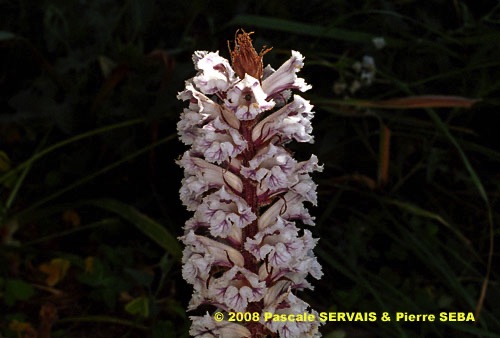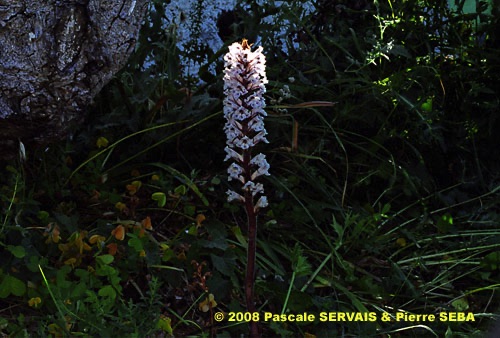
Orobanche crenata Forssk.
Fam. : Orobanchaceae
© Pascale SERVAIS & Pierre SEBA, 2018. Tilo Botanica: Flore de Tilos et du Dodécanèse / Flora of Tilos and of the Dodecanese
English translation by Brenda Bradbury, Howard Bradbury and Stéphane Léonard
Plante herbacée, hermaphrodite, parasite, sans chlorophylle, à tige florale simple, dressée, un peu renflée à la base, un peu poilue. À la fin de la floraison, la plante devient roussâtre et les fleurs prennent la consistance du papier.
Feuilles alternes, réduites à des écailles étroites, simples, linéaires à lancéolées, de 15 à 30 mm de long. Bractées linéaires à lancéolées, à longue pointe.
Fleurs à symétrie bilatérale, blanchâtres, veinées de lilas violacé, de 18 à 30 mm de long, réunies en épi terminal compact. Corolle un peu poilue, à lobes non ciliés, à 5 pétales soudés en tube, à 2 lèvres, la supérieure bilobée, l’inférieure trilobée et non ciliée. Calice à divisions étroites et aiguës. Chaque fleur sans bractéole. 4 étamines inégales, insérées à 2 à 4 mm au-dessus de la base de la corolle, à filet velu à la base. 1 style et 1 stigmate violet clair. Ovaire supère.
Fruits, capsules à nombreuses graines.
___________________________
Plant herbaceous, hermaphrodite, parasitic, without chlorophyl. Floral stem simple, erect, a little swollen at the base, a little hairy. At the end of flowering, the plant becomes reddish and the flowers take the consistency of paper.
Leaves alternate, reduced to narrow, simple, linear to lanceolate scales, from 15 to 30 mm long. Bracts linear to lanceolate, with a long point.
Flowers bilaterally symmetrical, whitish with purplish lilac veins, from 18 to 30 mm long, joined together in a compact terminal spike. Corolla a little hairy, with nonciliate lobes, with 5 petals fused in tube, with 2 lips, the higher one two-lobed, the lower one three-lobed and nonciliate. Calyx with narrow and acute divisions. Each flower without a bracteole. 4 unequal stamens inserted into 2 to 4 mm above the base of the corolla, with a filament very hairy at the base. 1 style and 1 pale violet stigma. Ovary superior.
Fruits, capsules with numerous seeds.
Descripteurs / Identifying features
1

2
Étymologie / Etymology :
Orobanche : emprunt du latin orobanche, -es (nom) = l’orobanche,
nom donné à la plante par Pline, naturaliste latin mort en 79 apr. J.-C.,
forme latinisée du grec ancien ὄροβάγχη, -ης (nom) [ < ὄροβος, -ου
(nom) = la vesce + ἄγχω (verbe) = serrer, étouffer ] = l’orobanche,
nom donné à la plante par Théophraste, philosophe péripatéticien,
disciple d’Aristote, botaniste et naturaliste, mort vers 288 av. J.-C., en
référence au caractère parasitaire de cette plante qui étouffe plusieurs
espèces de Fabaceae.
Crenata : emprunt du latin médiéval crenatus, -a, -um (adj.)
[ < crena, -ae (nom) = la dent arrondie ] = festonné, crénelé, bordé de
dents arrondies.
Orobanche : borrowed from Latin orobanche, -es (noun) = broomrape,
name given to the plant by Plinius, Latin naturalist died in 79 AD,
Latinized form of the Classical Greek ὄροβάγχη, -ης (noun)
[ < ὄροβος, -ου (noun) = vetch + ἄγχω (verb) = to tighten, to choke ]
= broomrape, name given to the plant by Theophrastus, peripatetic
philosopher, disciple of Aristotle, botanist and naturalist, died towards
288 BC, referring to the parasitic nature of this plant that chokes
several species of Fabaceae.
Crenata : borrowed from medieval Latin crenatus, -a, -um (adj)
[ < crena, -ae (noun) = rounded tooth ] = notched, crenate, edged
with rounded teeth.
Synonymes / Synonyms :
Orobanche angustisepala F.W.Schultz
Orobanche canescens Spruner
Orobanche cyamophya St.-Lag.
Orobanche grandiflora Chaub.
Orobanche pelargonii Caldesi
Orobanche pruinosa Lapeyr.
Orobanche segetum Spruner
Orobanche speciosa DC.
Orobanche viciaefabae F.W.Schultz
Noms vernaculaires / Common names :
Nom français / French name :
Orobanche crénelée.
Noms grecs / Greek names :
Λουλούδι μπλέ — Λύκος — Λυκόχορτο — Μπλέ λουλούδι —
Οροβάγχη — Ρούβαλο — Τσουβέλι.
Noms anglais / English names :
Bean broomrape — Brown broomrape —
Carnation scented broomrape — Crenate broomrape.
Noms allemands / German names :
Braune Sommerwurz — Gezähnelte Sommerwurz —
Gezähnte Sommerwurz.
Noms espagnols / Spanish names :
Espárrago de loba — Hierba tora — Jopo — Matalegumbre.
Noms italiens / Italian names :
Lupo di Fave — Succiamele delle fave.
Habitat :
Cultures - Jardins - Chemins.
Cultivated places - Gardens - Waysides.
Îles / Islands :
Patmos - Tilos.
Hauteur / Height range :
De 30 cm à 1 m.
From 30 cm to 1 m.
Floraison / Flowering time :
De février à mai.
From February to May.
Groupe / Classification :
Dicotylédones.
Dicotyledons.
Pérennité / Lifespan :
Annuelle ou vivace.
Annual or perennial.
Description :
Clés dichotomiques et descripteurs distinctifs des 5 espèces / Dichotomous keys and distinctive identifying features of the 5 species
Photo 1 :
Localisation / Location : Patmos, Chora, Ancien chemin
Date : 29/04/2005
GPS : Lat. 37,31692° N / Long. 26,54351° E / Alt. 61 m
Type : Kodak Gold 200 ASA
Photo 2 :
Localisation / Location : Patmos, Chora, Ancien chemin
Date : 29/04/2005
GPS : Lat. 37,31692° N / Long. 26,54351° E / Alt. 61 m
Type : Kodak Gold 200 ASA

Google Maps
Google Maps